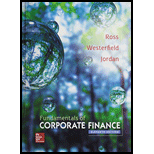
Concept explainers
Cost of Capital for Swan Motors
You have recently been hired by Swan Motors, Inc. (SMI) in its relatively new treasury management department. SMI was founded eight years ago by Joe Swan. Joe found a method to manufacture a cheaper battery that will hold a larger charge, giving a car powered by the battery a range of 700 miles before requiring a charge. The cars manufactured by SMI are midsized and carry a price that allows the company to compete with other mainstream auto manufacturers. The company is privately owned by Joe and his family, and it had sales of $97 million last year.
SMI primarily sells to customers who buy the cars online, although it does have a limited number of company-owned dealerships. Most sales are online. The customer selects any customization and makes a deposit of 20 percent of the purchase price. After the order is taken, the car is made to order, typically within 45 days. SMI’s growth to date has come from its profits. When the company had sufficient capital, it would expand production. Relatively little formal analysis has been used in its capital budgeting process. Joe has just read about capital budgeting techniques and has come to you for help. For starters, the company has never attempted to determine its cost of capital, and Joe would like you to perform the analysis. Because the company is privately owned, it is difficult to determine the
2. To estimate the cost of equity for TSLA, go to finance. yahoo.com and enter the ticker symbol TSLA. Follow the links to answer the following questions: What is the most recent stock price listed for TSLA? What is the market value of equity, or market capitalization? How many shares of stock does TSLA have outstanding? What is the most recent annual dividend? Can you use the
Want to see the full answer?
Check out a sample textbook solution
Chapter 14 Solutions
Fundamentals of Corporate Finance with Connect Access Card
- I need help! A company’s weighted average cost of capital (WACC) is used to: A) Determine the average cost of producing goods B) Evaluate the return on investment projects C) Estimate the company's growth rate D) Measure the level of debt in the companyarrow_forwardNeed help!! What does the term "liquidity" refer to in finance? A) The ability to convert assets into cash quickly without significant loss of value B) The ability to increase company profits C) The level of debt in the company D) The diversity of the investment portfolioarrow_forwardI need answer step by step. A company’s weighted average cost of capital (WACC) is used to: A) Determine the average cost of producing goods B) Evaluate the return on investment projects C) Estimate the company's growth rate D) Measure the level of debt in the companyarrow_forward
- Don't use ai A company’s weighted average cost of capital (WACC) is used to: A) Determine the average cost of producing goods B) Evaluate the return on investment projects C) Estimate the company's growth rate D) Measure the level of debt in the companyarrow_forwardA company’s weighted average cost of capital (WACC) is used to: A) Determine the average cost of producing goods B) Evaluate the return on investment projects C) Estimate the company's growth rate D) Measure the level of debt in the companyarrow_forwardI need help! Which of the following best defines "diversification" in investment? A) Investing in a single type of asset for high returns B) Spreading investments across different assets to reduce risk C) Putting all funds into low-risk bonds D) Focusing on high-risk, high-return investmentsarrow_forward
- Which of the following best defines "diversification" in investment? A) Investing in a single type of asset for high returns B) Spreading investments across different assets to reduce risk C) Putting all funds into low-risk bonds D) Focusing on high-risk, high-return investmentsarrow_forwardWhich of the following best describes the "efficient market hypothesis"? A) Stocks are always priced higher than their actual value. B) It is impossible to outperform the market consistently due to all information being already reflected in stock prices. C) Only insider information can help outperform the market. D) The market reacts slowly to new information.arrow_forwardThe "time value of money" concept states that: A) Money today is worth more than the same amount in the future B) Money tomorrow is worth more than today’s money C) Money and time have no relation in financial decisions D) Time has no impact on financial investmentsarrow_forward
- I need help. If net income is $25,000 and total equity is $125,000, what is the return on equity (ROE)?A. 10%B. 15%C. 20%D. 25%arrow_forwardI need help!!Which of the following is NOT a type of financial market? A) Capital Market B) Money Market C) Labor Market D) Commodity Marketarrow_forwardWhich of the following is NOT a type of financial market? A) Capital Market B) Money Market C) Labor Market D) Commodity Marketarrow_forward
 Cornerstones of Cost Management (Cornerstones Ser...AccountingISBN:9781305970663Author:Don R. Hansen, Maryanne M. MowenPublisher:Cengage Learning
Cornerstones of Cost Management (Cornerstones Ser...AccountingISBN:9781305970663Author:Don R. Hansen, Maryanne M. MowenPublisher:Cengage Learning Managerial Accounting: The Cornerstone of Busines...AccountingISBN:9781337115773Author:Maryanne M. Mowen, Don R. Hansen, Dan L. HeitgerPublisher:Cengage Learning
Managerial Accounting: The Cornerstone of Busines...AccountingISBN:9781337115773Author:Maryanne M. Mowen, Don R. Hansen, Dan L. HeitgerPublisher:Cengage Learning EBK CONTEMPORARY FINANCIAL MANAGEMENTFinanceISBN:9781337514835Author:MOYERPublisher:CENGAGE LEARNING - CONSIGNMENT
EBK CONTEMPORARY FINANCIAL MANAGEMENTFinanceISBN:9781337514835Author:MOYERPublisher:CENGAGE LEARNING - CONSIGNMENT


